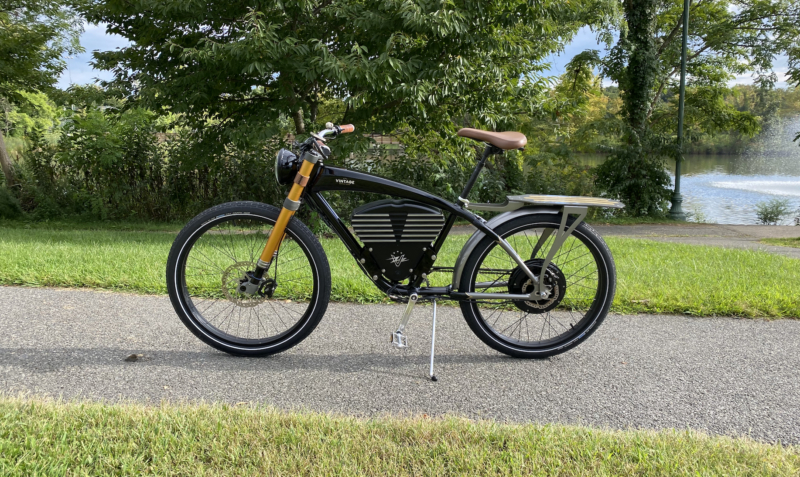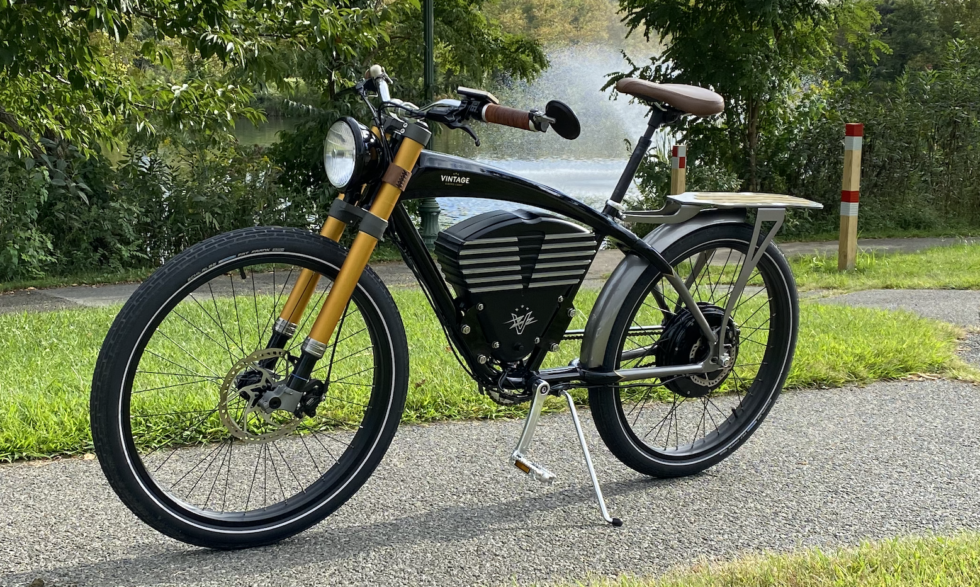
John Timmer
“You can let everyone know that people said it’s a really nice-looking bike.”
I’d never received comments like that when testing previous e-bikes, but I got compliments several times when out on the Vintage Roadster, and it’s easy to see why. The bike is gorgeous, evoking classic motorcycles of a century ago, straight down to a battery shaped like a two-cylinder engine.
For me, it constantly called to mind the opening scenes of Lawrence of Arabia, which show Lawrence speeding off on one of those classic machines. Those who have seen the film know that the scenes end with his death in a motorcycle crash. This brings me to my mixed feelings about Vintage’s e-bike equivalent of a supercar. I was introduced to the Vintage after I reviewed a Super73 e-bike, about which I expressed some concern over how easy it was to accelerate the bike to a very illegal (and potentially dangerous) 50 km an hour. Vintage’s sales pitch for the Roadster was basically “we have one that goes even faster.”
Naturally, I had to try it out.
A super e-bike
Supercars are a high-priced mix of performance and design. The former means the car is overprovisioned for most reasonable uses, while the latter involves the designers thinking of everything to make sure that customers who fork over ungodly amounts of money never come across any annoyances. Given that definition, the Roadster is definitely the equivalent of a supercar.
We’ll come back to the performance, but for now, we can say that the Roadster definitely qualifies as overprovisioned. And with a price tag just shy of $7,000, it’s not cheap. To put that price into context, however, ultra-lightweight carbon fiber bikes with high-end components can cost well above $10,000, and those bikes require you to do all the work to keep them moving.
Just like buying a supercar, choosing the Roadster requires you to determine whether the design and performance are good enough to justify the price gap between it and more utilitarian options.
As mentioned above, many onlookers felt the design was compelling. Vintage went all-in on the classic motorcycle look; the handlebars, headlight, and seat all feed into the aesthetic. Both the battery and the shock-absorbing front forks are special designs meant to enhance the motorcycle-like appearance as well. The optional rear rack matches the color and styling of the bike perfectly.

John Timmer
Vintage also included some nice design touches beyond the aesthetics. Since the forks extend up to the handlebars, a sharp turn could cause a bump to the frame itself, so Vintage has wrapped leather straps around the forks to cushion the frame (the straps match the leather grips on the handlebars and the leather seat).
Is this a “they thought of everything” design? It’s close, but not quite. Obviously, the pedals and kickstand detract a bit from the motorcycle vibe, and on the Roadster, their bright chrome stands out from the dark paint on the frame. The rear light is just a row of red LEDs embedded in plastic. And rather than coming up with a circular, motorcycle-like display for speed, battery, and assist level (as Super73 did), Vintage went with a generic rectangular LCD that the designers tried to make inconspicuous. But these are pretty minor deviations from a carefully thought-out aesthetic; this is an utterly gorgeous bike with many thoughtful design touches.
But that beautiful design brings up a question. The Roadster is a fantastic machine for running errands, but will you feel comfortable leaving something that looks like it belongs in a design museum sitting outside a Home Depot? (This may be another parallel it shares with supercars.)








